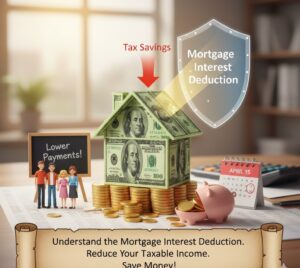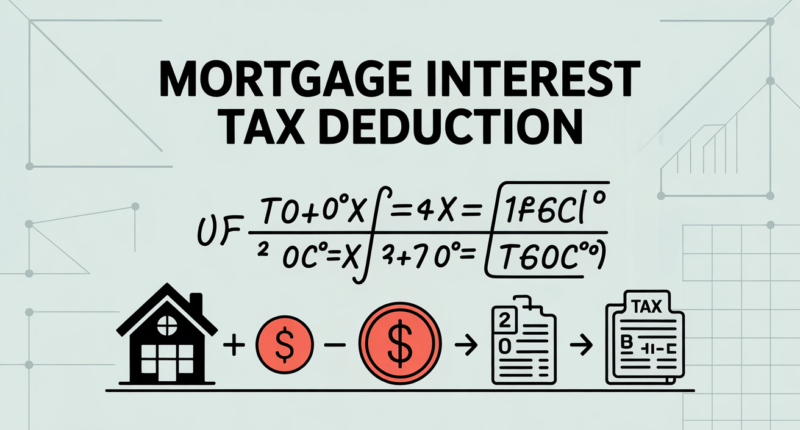Understand the mortgage interest deduction

Homeowners in the United States may reduce their taxable income by deducting interest paid on home mortgages, but they must itemize deductions on Schedule A rather than claim the standard deduction. The deduction is limited to the first $750 000 of mortgage debt for mortgages taken out after 15 December 2017; married taxpayers filing separately are capped at $375 000.
For mortgages obtained before 16 December 2017, interest on the first $1 million ($500 000 if married filing separately) remains deductible. These limits apply to primary and second homes and require that the loan be secured by the property. Consequently, many taxpayers who bought in high‑priced markets or refinanced large loans need to calculate how much of their mortgage interest qualifies.
Recognize debt types and use of loan proceeds
Investors should distinguish between acquisition debt—funds used to buy, construct or substantially improve a home—and other mortgage proceeds. The IRS allows itemized deductions only for acquisition debt and prohibits deductions for interest allocated to non‑qualifying uses. Loans taken between October 1987 and December 2017 qualify up to $1 million in acquisition debt, while those originated between December 2017 and December 2025 are limited to $750 000.
If you use mortgage proceeds for personal expenses or unrelated investments, that portion of interest is not deductible. Real‑estate investors who convert part of their home into rental space or obtain a mortgage to fund rental properties must allocate interest accordingly and may deduct only the portion related to the rental business.
Calculating the deductible interest: the formula
Once you know your loan limits, calculate the average mortgage balance for the year. When the average balance exceeds the applicable limit, the IRS requires a pro‑ration: you multiply the interest paid by the ratio of the limit to your average mortgage balance. Put simply, the formula is:
-
Deductible interest = Loan limit ÷ Average mortgage balance × Total interest paid.
This approach ensures that taxpayers with large mortgages only deduct interest on the portion of debt within the allowable limit. According to The Finance Buff, if you paid $30 000 in interest on an average mortgage balance of $1 million and are subject to the $750 000 limit, your deductible interest equals $750 000 ÷ $1 000 000 × $30 000, which is $22 500.
Estimating your average mortgage balance
There are several methods to compute the average mortgage balance: (1) the average of first and last balance (take beginning and end‑of‑year balances and average them); (2) interest paid ÷ interest rate, which assumes no rate changes and that you did not prepay more than one month of principal; and (3) the monthly statements method, which averages balances from each monthly statement.
For example, if you paid $30 000 in mortgage interest at a fixed rate of 2.875 %, your average balance using method 2 would be $30 000 ÷ 0.02875 = $1 043 478. Because this balance exceeds the $750 000 limit, your deductible interest becomes $750 000 ÷ $1 043 478 × $30 000 ≈ $21 562. Investors who prepaid multiple months of principal or experienced interest‑rate changes should use monthly statements to get an accurate average.
Real‑world example for homeowners
Imagine a U.S. investor who bought a residence in 2024 using an $800 000 mortgage at 5 %. During 2025, the investor paid $38 000 in interest. Because the mortgage was originated after the Tax Cuts and Jobs Act, the loan limit for the mortgage interest deduction is $750 000. The average mortgage balance computed from monthly statements is $780 000.
Applying the formula, the investor’s deductible interest equals $750 000 ÷ $780 000 × $38 000, resulting in a deduction of approximately $36 538. The remaining $1 462 of interest is nondeductible. If the same property had been purchased before 16 December 2017, the investor could deduct the full $38 000 because the loan would fall under the $1 million limit.
Implications for rental properties
While the home mortgage interest deduction benefits homeowners, rental property owners deduct mortgage interest differently. Landlords report mortgage interest on Schedule E as a business expense rather than on Schedule A, so the $750 000 limit does not apply.
For example, if an investor buys a rental property for $600 000 with a $400 000 mortgage and pays $20 000 in interest during the first year, the entire $20 000 is deducted from rental income, reducing taxable rental income from $60 000 to $40 000. However, landlords must allocate interest between personal and rental use; only the portion related to rental activities is deductible. They must also ensure the property is available for rent; interest accrued during personal use periods is not deductiblebaselane.com.
Steps to claim the mortgage interest deduction
-
Obtain Form 1098: Your lender sends Form 1098 summarizing mortgage interest paid; you need this to support your deduction.
-
Compute your average balance: Choose the appropriate method (first‑and‑last balance, interest paid ÷ rate, or monthly statements) and determine if your balance exceeds the applicable loan limit.
-
Calculate deductible interest: Use the formula above to pro‑rate interest if necessary.
-
Itemize on Schedule A: Enter deductible mortgage interest on Schedule A of Form 1040; if your total itemized deductions do not exceed the standard deduction, itemizing may not be beneficial.
-
Maintain records: Keep documentation such as loan statements and closing documents in case of auditnerdwallet.com.
Key takeaways for investors
The mortgage interest deduction can significantly reduce taxable income for investors who finance their homes. Yet the benefit is subject to strict limits and documentation requirements, and it only applies if you choose to itemize. Always verify how your loan was used—only acquisition debt qualifies—and ensure that you adjust interest deductions when you occupy part of a rental property or use loan proceeds for personal reasonsbaselane.com.
When your mortgage balance exceeds the allowable limit, apply the simple formula: Deductible interest = Loan limit ÷ Average mortgage balance × Total interest paid, and pro‑rate accordinglythefinancebuff.com. Finally, consult a tax professional if your situation involves multiple properties, refinances or complex allocations.









